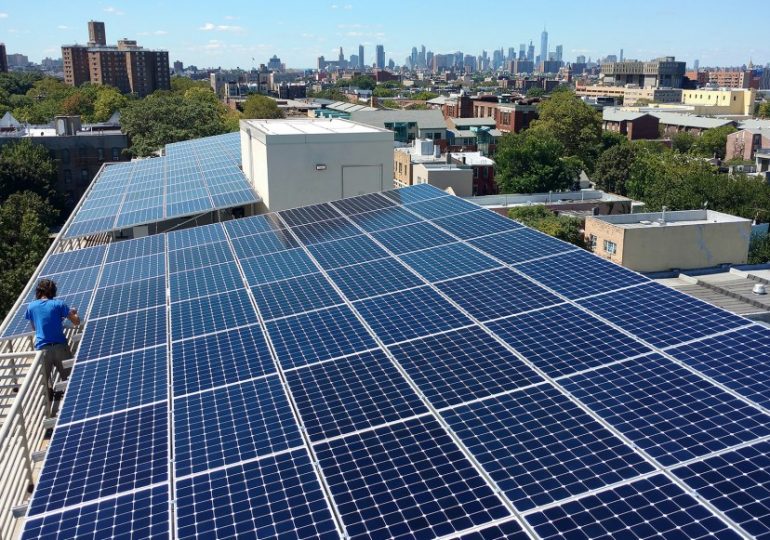Illinois has $30 million in incentives available for solar installations on multi-family buildings.
So far, though, the state program has not received any applications for such projects, according to Jan Gudell, Illinois Solar for All associate director at Elevate, the organization tasked with running the state program.
In urban areas like Chicago, residents of environmental justice and lower-income neighborhoods are highly likely to live in multi-family residential buildings where it is extremely difficult to install rooftop solar.
There is little incentive for a landlord to invest in solar that will provide cost savings to the tenants, and rooftops may need significant upgrades to handle solar. In condo buildings, homeowners association bureaucracy and other concerns must be navigated.
There’s also a lesser-known logistical and structural barrier – if solar is to be channeled to individual residential units behind the meter, a separate solar system is essentially needed for each unit — with separate inverters and wiring.
“That’s a lot of hardware, space and cost,” said Aliya Bagewadi, US director of strategic partnerships for Allume Energy, an Australian startup company that says it can address at least this part of the puzzle, by sending energy to individual units with only one inverter and system.
The company has served thousands of customers in Australia, New Zealand and Europe with its SolShare technology. Now it is rolling out in the U.S., in sunny southern states as well as Illinois, because of the state’s robust solar incentives.
“It’s inherently an energy equity issue,” said Bagewadi, who is based in Chicago. “We know [multi-family building residents] are much more likely to be lower-income, longer-term renters. We want to make sure those savings flow to people who can really benefit the most.”
Direct benefits
Illinois isn’t alone in the lack of multi-family solar arrays. Solar developers and advocates have long noted the challenge nationwide, especially for affordable multi-family rental buildings. A 2022 study by Berkeley lab noted that in 2021, about 3% of solar installed in the U.S. was on multi-family buildings, mostly owner-occupied condos.
“Solar may be a non-starter in a rental multi-family property because the owner may be looking at a complex, expensive and time-consuming process, where they would have to consider the design, permitting, installation, interconnection, and cost for multiple systems,” said Gudell. “For many property owners, this may be unaffordable and unimaginable.”
A 2018 study by the National Renewable Energy Laboratory found that the majority of potential capacity for new solar serving low- and moderate-income customers is on renter-occupied multi-family rooftops. California passed a law in 2015 specifically to address the dearth of solar on multi-family buildings, promising to invest up to $1 billion by 2031.
There are typically several ways to handle rooftop solar on multi-family buildings.
In rental properties, the building owner can own the array, and use the energy to power common areas, like hallways, a pool or gym. Owners can also allocate a portion of the energy savings to tenants, by charging an amenity fee or otherwise collecting some revenue themselves.
Alternately, the energy can all be sent back to the grid, in areas with viable net metering policies, and the compensation can be shared with tenants or among condo owners, often referred to as virtual net metering. Community solar offers a similar situation — where the solar isn’t onsite at all, but residents can subscribe to partake in savings.
Solar advocates, developers, lenders, and policymakers have all been working at state and federal levels to improve opportunities for virtual net metering and community solar.
These arrangements, however, can still be unattractive or impossible depending on state and utility policy. Community solar isn’t even legal in some states, and virtual net metering depends on utility participation.
The California law requiring solar on new multi-family construction up to three stories high exempts areas served by utilities that don’t offer virtual net metering.
SolShare avoids these challenges by sending electricity directly from the solar array to individual users, without involving utilities or the grid.
“You can do behind-the-meter with direct benefit to tenants,” said Bagewadi. “We’re physically pushing the electrons to multiple meters.”
Possibilities
Allume partners with solar installers and developers to help deploy rooftop solar on multi-family buildings, including by working with landlords to design financial structures that benefit both the building owner and tenants. In some cases, Allume acts as the solar developer itself.
With SolShare, a building owner or manager can allocate energy from a shared solar system, based on unit square footage, in equal amounts, or however they choose.
Where the technology is deployed in Australia and the UK, energy can be sent to different units on demand, Bagewadi explained. In the U.S., the rollout in Florida and Mississippi is being done with preset amounts that can be changed with 24 hours notice.
An Allume case study from a 64-unit Orlando apartment building with SolShare notes that a 392-kilowatt rooftop system resulted in savings of almost $100 per month for each unit, with electricity purchased from the grid reduced by almost 60%. While the idea is for residents to use solar behind the meter, excess solar can be sent to the grid. Adding an on-site battery to the mix lets residents use all the power on-site behind the meter, and makes solar power available when the grid is down.
Solar advocates hope the EPA’s $7 billion commitment to the federal equity-focused Solar for All program — separate from Illinois’s state program — will “further unlock multi-family solar,” in Bagewadi’s words.
Gudell said Elevate and other experts know there are many Illinoisans living in multi-family rental buildings that would qualify to have solar installed through Illinois Solar for All. They hope policy and technology evolve to match the available funding.
“We’ll need a solution that addresses the split incentive problem for rental situations, where the building owner cannot or will not subsidize solar for tenants; and the complexity of bringing solar to multiple electrical accounts at one building,” Gudell said.
“Adoption of a technology that allows for a single system to be split into shares, for use by multiple electrical account holders, could help in that it would simplify the design, permitting and installation process.”
Startup pitches new model to unlock solar for multi-family buildings, in Illinois and beyond is an article from Energy News Network, a nonprofit news service covering the clean energy transition. If you would like to support us please make a donation.
Leave a comment




